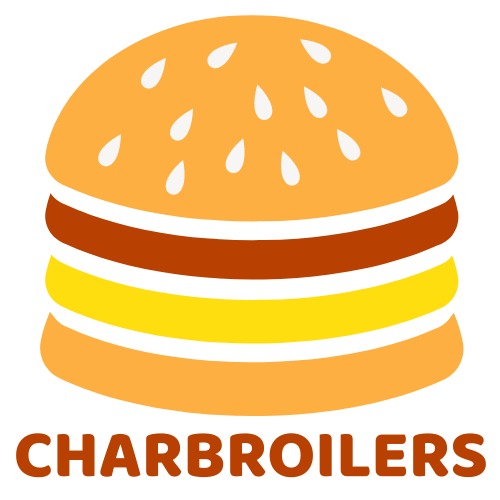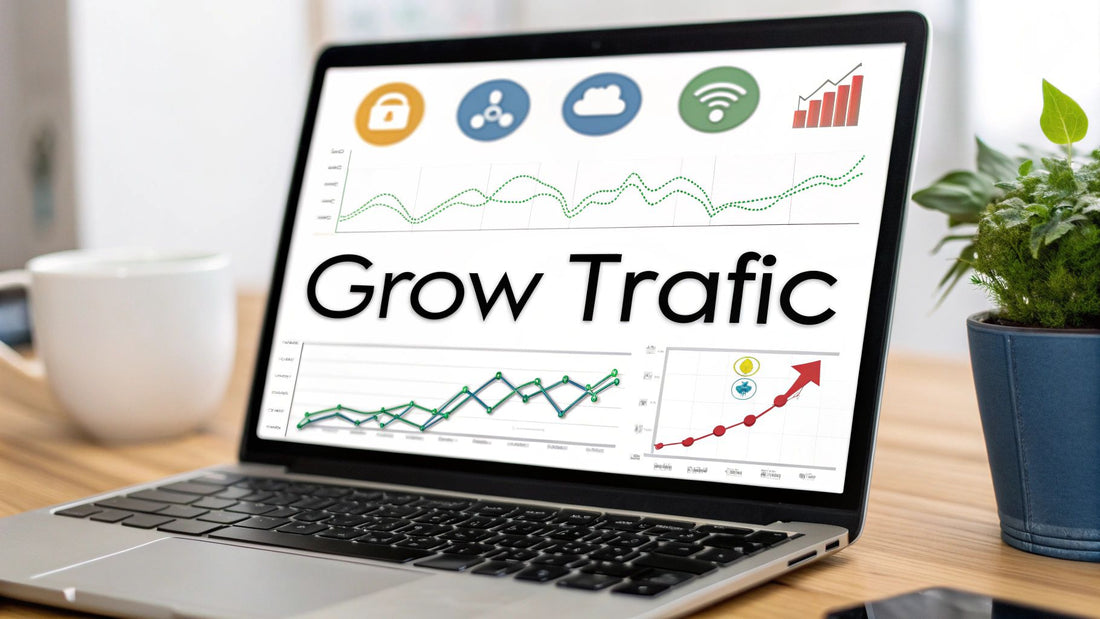
How to Promote Your Website: A Guide for Restaurant Equipment Suppliers
Share
Before you write a single blog post or run an ad, you need a solid game plan. Promoting a website isn't about throwing things at the wall to see what sticks. It’s about building a foundation that supports every single move you make, especially in the competitive restaurant equipment supply industry.
Think of it like this: just knowing your customer is a "restaurant owner" isn't enough. You need to get into their head. What keeps them up at night? Are they frantically searching for a replacement oven during dinner service, or are they a chef planning a dream kitchen from scratch? The answers change everything about how you promote your web presence.
This early stage is where you decide who you’re talking to, what winning looks like, and how search engines will even find you in the first place. Skipping this is like building a kitchen on a weak foundation. It might look okay for a little while, but it’s destined to fail.
This infographic breaks down the three critical pillars you need to get right from the start: nailing your audience, getting your SEO in order, and setting goals you can actually track.
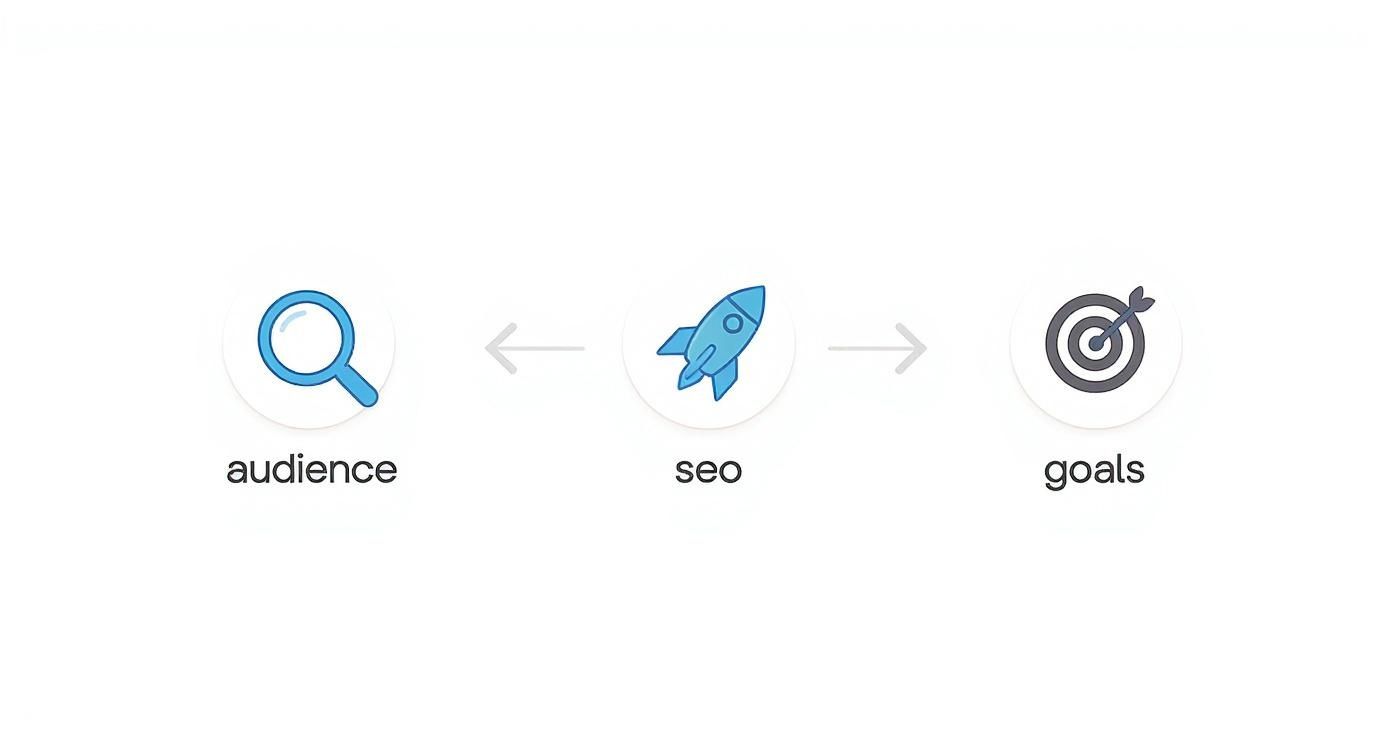
As you can see, they all work together. Get one wrong, and the others will suffer.
To make this crystal clear, let's look at the main channels you'll be using. This table summarizes the core methods for promoting your website, what each one is really for, and how you can tell if it's actually working.
Your Core Website Promotion Channels
| Promotion Channel | Primary Goal | Key Performance Indicator (KPI) |
|---|---|---|
| Search Engine Optimization (SEO) | Attract organic traffic from search engines | Keyword rankings, organic traffic, conversion rate |
| Content Marketing | Build authority and engage your audience | Time on page, social shares, leads generated |
| Social Media Marketing | Increase brand awareness and community | Follower growth, engagement rate, website clicks |
| Paid Advertising (PPC) | Drive targeted traffic and immediate leads | Click-through rate (CTR), cost per acquisition (CPA) |
| Email Marketing | Nurture leads and drive repeat business | Open rate, click-through rate, unsubscribe rate |
Each channel has its place, but they all depend on the foundational strategy we're about to build.
Define Your Target Audience
You have to know exactly who you're talking to. What are their online habits? What are their biggest frustrations? What finally pushes them to make a purchase?
Are you trying to reach a frantic restaurant manager who needs fast, reliable specs on commercial ovens? Or is it a visionary chef looking for cutting-edge kitchen inspiration? The language, content, and channels you use will be completely different for each.
A deep understanding of your audience informs every aspect of your strategy, from the keywords you target in your blog posts to the ad copy you write. It’s the difference between shouting into the void and having a meaningful conversation with potential customers.
Establish Clear and Measurable Goals
"Get more traffic" is not a goal. It's a wish. To make real progress, you need specific, measurable objectives that you can point to and say, "We did that."
Here are a few examples of what real goals look like for a restaurant equipment supplier:
- Increase qualified leads from organic search by 15% in the next quarter.
- Achieve a top-3 ranking for the keyword "commercial charbroiler reviews."
- Generate 50 new email subscribers per month from our blog content.
These kinds of targets give you a benchmark to measure success and prove that your marketing budget is money well spent. If you need more ideas on how to get things moving, check out these 9 Proven Ways to Increase Website Traffic.
Master Technical SEO Basics
The technical health of your website is absolutely non-negotiable. Google and other search engines are obsessed with user experience, which means they reward sites that are fast, mobile-friendly, and easy for people to use.
The competition is fierce. The top result on Google gets almost 40% of all clicks. If your site is slow or broken on mobile, you’re not even in the game. You're just handing traffic and sales over to your competitors.
Before you pour money into content or ads, run a full diagnostic on your site. You might be surprised by what you find. For a step-by-step walkthrough, our guide on how to perform a website audit is the perfect place to start.
Attracting Organic Traffic with Smart SEO

If you're tired of paying for every single click, Search Engine Optimization (SEO) is your answer. Think of it as the engine that drives consistent, long-term traffic to your website, and it's all about making your site more visible to people who are already looking for what you offer. To really get a handle on promoting your website for the long haul, you first need a solid grasp of what is Search Engine Optimization (SEO) and how it works.
Forget about old-school tricks. Today's SEO is all about creating a genuinely valuable experience for your users—something search engines like Google want to reward. This really boils down to aligning your website's content with the specific questions and problems your target audience has.
For a restaurant equipment supplier, this means understanding the crucial difference between a search for "commercial oven prices" (someone ready to buy) and "how to clean a commercial oven" (someone looking for information). Both searches are golden opportunities to connect with customers, as long as you provide the right answer at the right time.
Uncovering Customer Intent with Keyword Research
Any smart SEO strategy starts with keyword research. This isn't just about finding popular words; it's about digging into the exact phrases your ideal customers are typing into search engines. This process tells you not just what they're searching for, but more importantly, why they're searching.
You have to think beyond simple, one-word terms. The real magic is in long-tail keywords—those longer, more specific phrases that signal a user is much closer to making a decision. For example, instead of just targeting "charbroilers," a much sharper approach would be to go after phrases like:
- "Best countertop gas charbroiler for small bistro"
- "Floor model charbroiler maintenance checklist"
- "Modular charbroiler vs. standalone unit"
Sure, these detailed searches have less volume, but their conversion potential is through the roof. You’re catching users with a specific, immediate need.
Optimizing Your On-Page Experience
On-page SEO is all about optimizing individual web pages so they can rank higher and pull in more relevant traffic. This is more than just sprinkling in keywords; it’s about structuring your content in a way that’s easy for both people and search engine bots to understand. Every single page on your site needs a clear job.
Here are the key on-page elements to nail down:
- Title Tags: This is your clickable headline in the search results. It has to be compelling and should include your main keyword.
- Meta Descriptions: This is the little blurb under your title. While not a direct ranking factor, a good one convinces people to click on your link instead of someone else's.
- Header Tags (H1, H2, H3): Use these to organize your content logically. This makes it scannable for readers and helps search engines understand the page's structure and topics.
- Internal Linking: Make sure to link to other relevant pages on your own website. This helps search engines find more of your content and, just as importantly, keeps visitors on your site longer. You can learn more about how this drives results in our guide on what is organic traffic.
Pro Tip: Don't neglect your URL structure. Keep URLs short, descriptive, and clean. A URL like
your-site.com/equipment/gas-charbroilersis way better for users and SEO thanyour-site.com/cat-1/prod-id-8374hgd.
Building Authority with Off-Page SEO
Off-page SEO covers all the actions you take outside of your website to improve your rankings. For the most part, this means building high-quality backlinks—which are simply links from other reputable websites pointing to yours. Every quality backlink is like a vote of confidence, telling search engines that your site is trustworthy.
For a restaurant equipment supplier, local citation services are a total game-changer. These services ensure your business's name, address, and phone number (NAP) are listed accurately and consistently across dozens of online directories like Yelp, industry-specific portals, and local business associations. Consistent citations are critical for ranking in local search results and on Google Maps, putting you right in front of nearby customers who are ready to buy.
Using Content Marketing to Build Authority
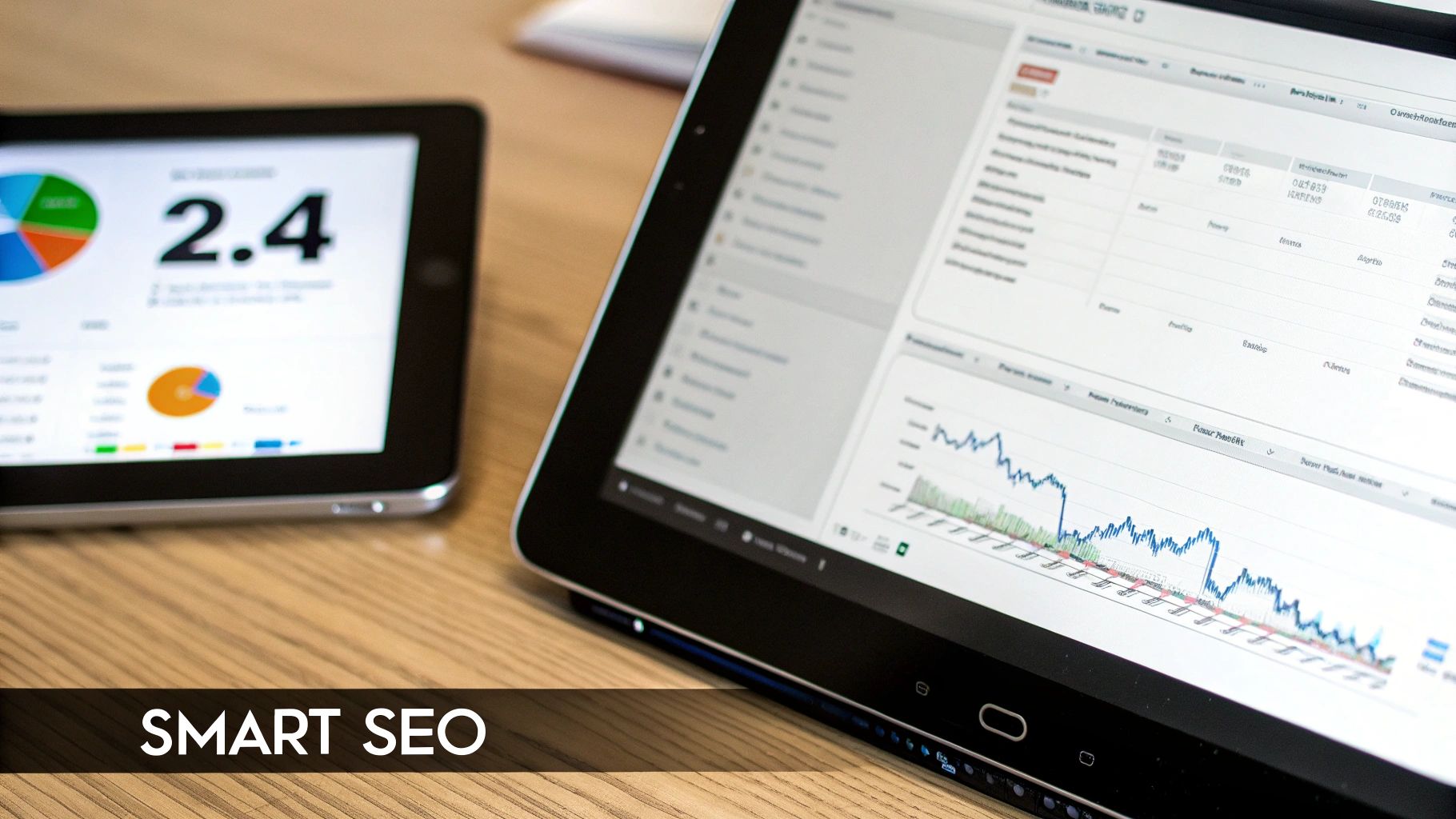
While smart SEO gets your website found, it’s your content that convinces people to stick around, trust you, and eventually make a purchase. Content marketing is all about creating and sharing genuinely useful information that solves your audience's real-world problems, establishing you as the go-to expert in your field.
Good content builds a relationship long before someone is even thinking about buying.
For a restaurant equipment supplier, this means getting inside the head of a chef or a restaurant manager. They aren't just buying a charbroiler; they're trying to solve a problem. They're likely wondering how to speed up kitchen workflow, whether gas or electric is better for their menu, or what a solid maintenance checklist looks like. Your content needs to answer those exact questions.
When you consistently put out high-value content, you’re not just selling—you’re demonstrating expertise and building confidence. It proves you understand their day-to-day challenges and have the right solutions. When it's finally time to buy, your brand becomes the obvious choice.
Brainstorming Content That Converts
The absolute best content ideas come straight from your customers' biggest headaches. Stop guessing what they want to know and start listening. The questions your sales team fields every day, the discussions happening in online forums, and even your competitors' blogs are all gold mines for topics with built-in demand.
Think about it: a blog post titled "5 Signs It’s Time to Replace Your Commercial Oven" hits on a specific pain point and pulls in an audience with clear intent to buy. That’s worlds more effective than a generic post about your company’s history.
Content marketing isn't about what you sell, but what you stand for. It’s about owning a topic in your customers' minds so that when they think of that topic, they think of you. Great content shifts the conversation from price to value.
The goal is to become the ultimate resource. A single helpful article can build more trust than a dozen sales calls ever could. Once you've built a library of this kind of content, every page becomes a digital asset working for you 24/7, attracting new visitors and warming up leads while you sleep.
Organizing Your Efforts With a Content Calendar
Ideas are cheap; execution is everything. A content calendar is a deceptively simple tool that turns your brilliant strategy into a concrete, actionable plan. It’s the key to staying consistent, which is non-negotiable for building an audience and keeping search engines happy.
Your calendar doesn't need to be fancy. A basic spreadsheet can do the trick. Just make sure you track:
- Publish Date: When the piece is scheduled to go live.
- Topic/Title: The working title for the blog post, guide, or video.
- Target Keyword: The main SEO phrase you’re aiming for.
- Content Format: Is this a blog post, a case study, a checklist, or a video?
- Author/Owner: Who is on the hook for getting it done?
This simple structure helps you cover a diverse range of topics and, more importantly, saves you from the last-minute scramble for ideas. If you need a hand turning those ideas into polished articles, our guide on how to write SEO-friendly blog posts breaks down the entire process.
Scaling Content Creation With Professional Help
Let's be real—maintaining a consistent publishing schedule is a heavy lift. As your business grows, you'll likely find you don't have the time or in-house expertise to churn out high-quality content regularly. This is where professional help becomes essential for promoting your website's authority.
Consider outsourcing to specialists in copyrighting and article writing for restaurant equipment supply websites. These experts understand the industry's nuances and can produce compelling content that resonates with chefs and managers. Additionally, blogger outreach services can place your content on relevant industry sites, earning powerful backlinks and exposing your brand to new, qualified audiences. It’s a smart way to maintain momentum without letting quality slide.
Driving Engagement with Social Media
So many people think social media is just a digital megaphone for shouting about their latest sale. But when you use it right, it becomes something much more powerful: a community hub. This is where you can build real relationships, prove you know your stuff, and pull qualified traffic straight back to your website.
The big shift happens when you stop shouting and start listening. If you're a restaurant equipment supplier, where do your actual customers—the chefs and foodservice managers—hang out online? Are they scrolling Instagram for kitchen design ideas? Or are they trading tips in professional LinkedIn groups? The answer to that question changes everything about your strategy.
Choosing the Right Platforms
Don't make the classic mistake of spreading yourself too thin trying to be everywhere at once. It’s a recipe for burnout and mediocre results. Instead, pour your energy into the one or two platforms where your ideal customers are already active and talking. A B2B brand selling high-end charbroilers, for instance, is going to get a lot more mileage out of LinkedIn than TikTok.
Before you even think about creating a profile, ask yourself these questions:
- Where do my customers network? For connecting with professionals like restaurant managers and executive chefs, LinkedIn is a no-brainer.
- Where do they look for inspiration? Visual platforms like Instagram and Pinterest are perfect for showing off equipment in a beautifully designed kitchen.
- Where do they go for advice? Niche communities, like private Facebook groups or specific subreddits for the culinary world, can be absolute goldmines for genuine conversations.
Creating Content That Connects
Once you know where you’re going to be, your focus has to shift from selling to serving. Your content needs to deliver real value. It should be the kind of thing that sparks a conversation and builds a little bit of trust every time you post. So, instead of another glossy product photo, think about what problems you can solve for your audience.
A short video showing the best way to clean a commercial charbroiler? That’s instantly useful. A post celebrating a local restaurant's success story using your equipment? That builds community and social proof. This whole approach positions you as a helpful expert, not just another supplier pushing a product.
The best social media promotion never feels like an ad. It feels like a helpful conversation. When you consistently show up with value, you earn the right to occasionally promote your products to an audience that’s already listening.
Let's not forget about paid social media, either—it's a huge player in modern web promotion. In fact, recent data shows that social content now influences the purchase decisions of 76% of users around the world. The trend is even stronger with younger crowds; 41% of Gen Z now use social media as their go-to for product research, putting it ahead of traditional search engines. You can dig into more of these digital marketing statistics to see how marketers are shifting their budgets to keep up.
Finally, there’s influencer marketing. A single, authentic shout-out from a respected local chef or a well-known industry blogger can easily outperform a big, slick ad campaign. It’s all about finding the trusted voices in your niche and building relationships that let them share your story with their own followers. It’s a powerful way to borrow credibility to drive real engagement and, ultimately, sales.
Scaling Your Reach with Paid Advertising
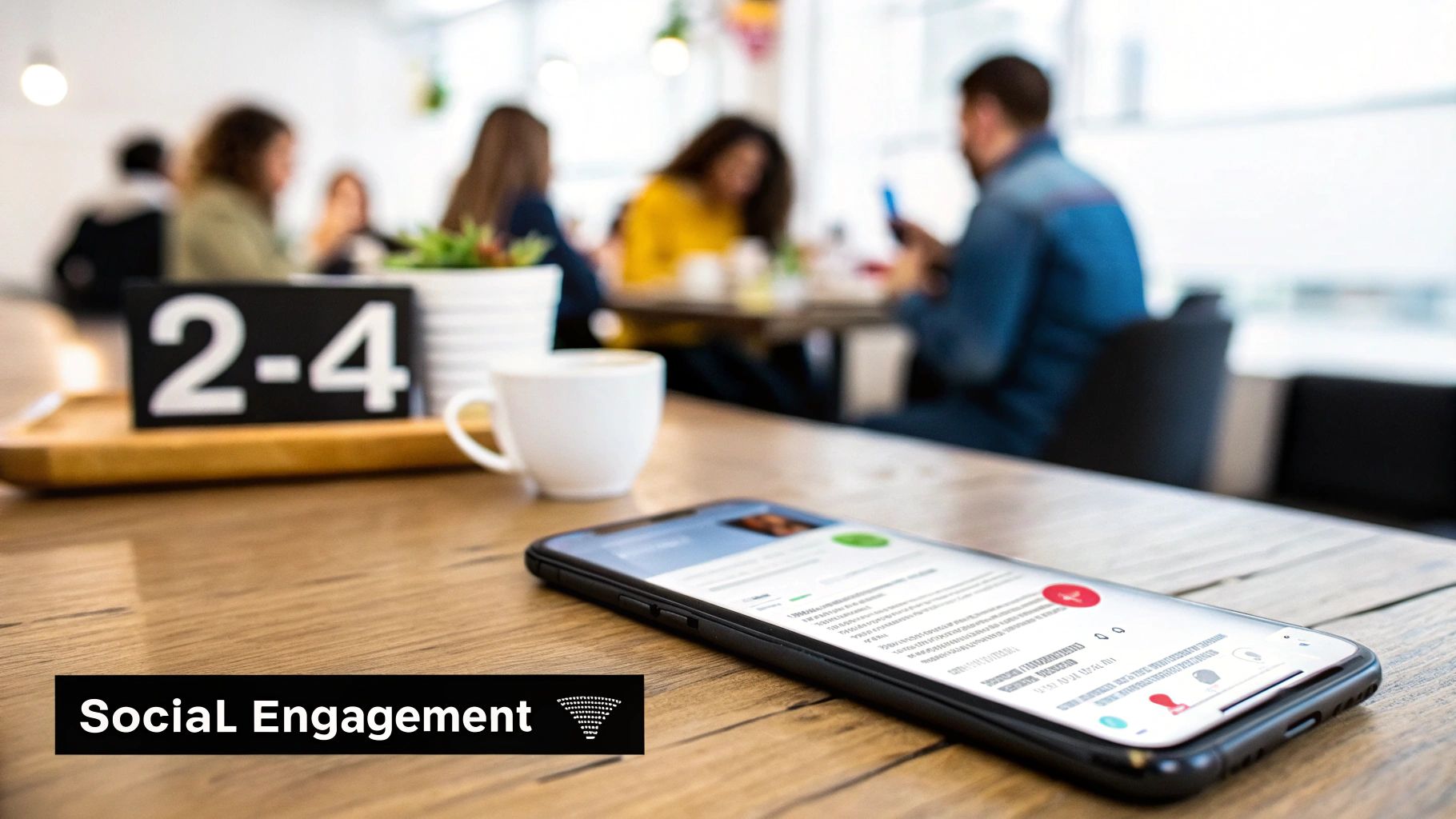
While organic strategies like SEO and content marketing are the foundation for long-term, sustainable traffic, they definitely take time to get going. Paid advertising, on the other hand, is like flipping a switch. It gives you immediate visibility, putting your brand right in front of potential customers at the exact moment they’re looking to buy. It’s a powerful tool when you need results now.
The shift to digital advertising is impossible to ignore. In fact, digital channels now make up 72.7% of all ad investment around the globe. Online ad spending is even projected to blow past $790 billion in 2024. That figure has more than doubled since 2019, which shows a massive change in how businesses are connecting with their audiences. You can dive deeper into this global digital overview to see just how big this trend is.
But this doesn't mean you need a bottomless budget to get in the game. The secret is a smart, targeted approach that delivers a solid return on investment (ROI). Forget the scattergun method; you need to focus your spend on the platforms and people most likely to actually convert.
Mastering Google Ads for High-Intent Users
When it comes to capturing user intent, Google Ads is the undisputed champ. You aren't just interrupting someone's social media scroll; you're putting a direct solution in front of a problem they are actively trying to solve right now. This is where you connect with customers typing in queries like "best commercial charbroiler for a small bistro" or "emergency commercial freezer repair."
The real beauty of Google Ads is its incredible specificity. You can target people based on the exact keywords they're searching for, where they're located, and even whether they've visited your site before (a tactic known as retargeting).
For a restaurant equipment supplier, this is gold. You can build campaigns that specifically target chefs in your city searching for floor model charbroilers. This ensures your ad spend is laser-focused on qualified leads who are already deep into the buying process.
Paid advertising accelerates the customer journey. While SEO builds a highway for future traffic, paid ads create an express lane for customers who are ready to buy today.
Hyper-Targeting with Social Media Ads
Social media advertising works on a totally different principle. Instead of targeting what people are searching for, it targets them based on who they are. Platforms like Facebook and LinkedIn offer stunningly detailed targeting options, letting you build custom audiences from demographics, interests, and professional data.
This approach is perfect for reaching people who might not be actively looking for your products but are an ideal fit. Imagine launching a Facebook ad campaign that targets individuals with job titles like "Restaurant Owner" or "Executive Chef" within a 20-mile radius of your business. It's a proactive way to generate new demand and build brand awareness with the exact professionals you want as customers.
Choosing Your Paid Advertising Platform
So, where should you put your money first? It really depends on your immediate goals. Both Google and social media have their strengths, and understanding the difference is key to getting the most out of your budget.
| Feature | Google Ads (Search) | Social Media Ads (e.g., Facebook) |
|---|---|---|
| Primary Targeting | Based on keywords and user search intent. | Based on demographics, interests, and behavior. |
| Best For | Capturing immediate, high-intent demand. | Building brand awareness and generating new demand. |
| User Mindset | Actively looking for a solution or product. | Passively browsing, open to discovery. |
Ultimately, Google Ads is your go-to for grabbing "hand-raisers"—people who are already looking for what you sell. Social media ads, in contrast, are fantastic for introducing your brand to a perfectly matched audience that just doesn't know you exist yet. A smart strategy often involves a mix of both.
Answering Your Top Website Promotion Questions
When you're trying to promote your website, a lot of questions pop up. From how much to spend to how long it'll take to see any real movement, getting straight answers can feel impossible. Let's cut through the noise and tackle some of the most common questions I hear.
Getting this right is especially critical if your business relies on reaching specific people, like restaurant owners or foodservice managers. The right information from the start saves you a ton of time, money, and headaches down the road.
How Much Should I Budget to Promote My Website?
Honestly, there's no magic number here. The right budget really depends on how competitive your market is, what you're trying to achieve, and how fast you need to get there.
A good rule of thumb for most businesses is to set aside 5% to 10% of your total revenue for marketing. If you're launching a brand-new website, you'll probably want to lean more heavily on paid ads at the beginning to get traffic flowing while your long-term SEO efforts start to build up steam.
The smartest way to figure out your budget is to test. Start with a smaller, controlled budget across a few different channels. Track the return on investment (ROI) for each one, and then pour more money into what's actually working.
For example, a restaurant equipment supplier is almost guaranteed to get a better ROI from a targeted Google Ads campaign for "commercial charbroilers" than from a vague social media campaign. Prove what works on a small scale, then double down.
How Long Does It Take to See Results from SEO?
Patience is everything when it comes to SEO. Think of it as a long-term investment in your brand's digital real estate, not a get-rich-quick scheme. You might see some small wins in a few weeks, but you should expect to see significant, needle-moving results in 4 to 12 months.
Several things can affect this timeline:
- Website Age: Newer domains just take longer to build up trust and authority with Google.
- Industry Competition: If you're in a crowded space, it's going to take more work to climb the rankings.
- Consistency: Success comes from showing up every day. You have to be consistent with your blog posting and link-building.
For local businesses, a well-optimized Google Business Profile can sometimes speed things up for local searches. But at the end of the day, consistency is what separates the campaigns that succeed from the ones that fizzle out. You can't just dip your toes in and expect a massive return.
What Is the Most Effective Way to Promote a New Website?
The best game plan for a new site is to attack from multiple angles, combining quick wins with long-term growth. Don't put all your eggs in one basket.
First, make sure your technical SEO foundation is solid. Once that's handled, launch a targeted Google Ads campaign to get traffic coming in right away. This isn't just about getting clicks; it also gives you priceless data on which keywords actually turn into customers.
At the same time, start building out a library of high-quality "pillar" content that answers the biggest questions your customers have. Push this content out on the social media platforms where your audience actually hangs out and start reaching out to bloggers to earn those first crucial backlinks. This mix of paid and organic strategies gives you immediate traction while you build the assets you need for sustainable growth.
At Charbroilers.com, we know that getting your products in front of the right chefs and restaurant owners is crucial. If you're looking to elevate your culinary offerings with top-tier equipment that delivers that perfect char-grilled texture and flavor, explore our selection of commercial charbroilers.
